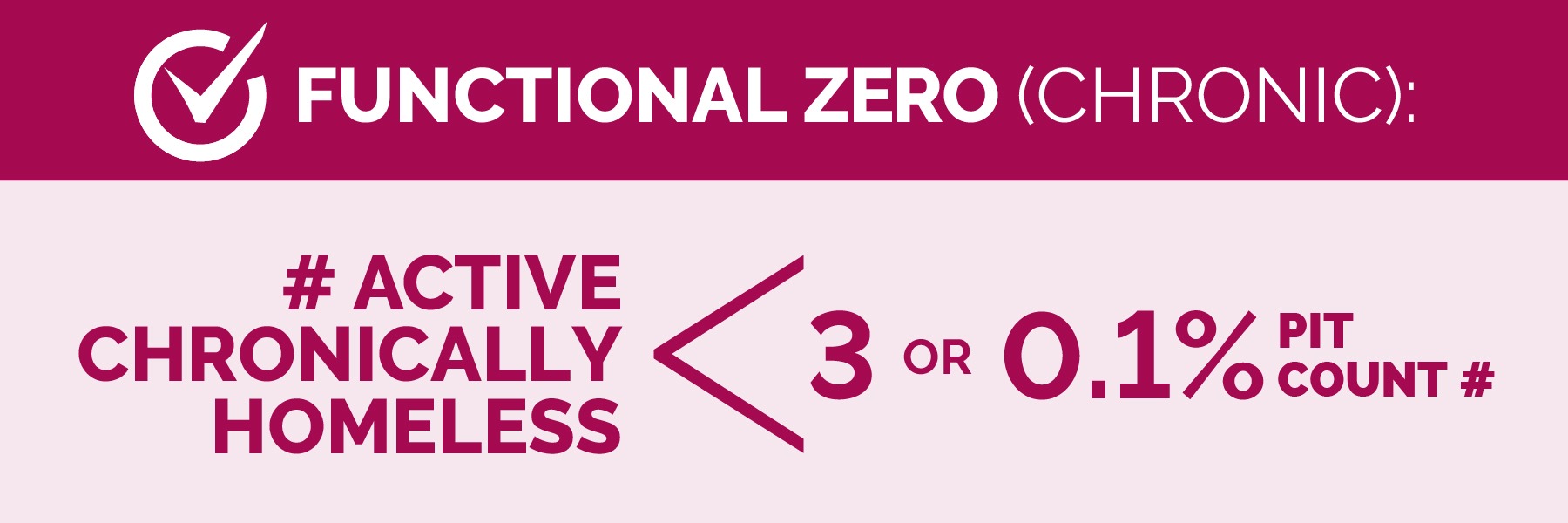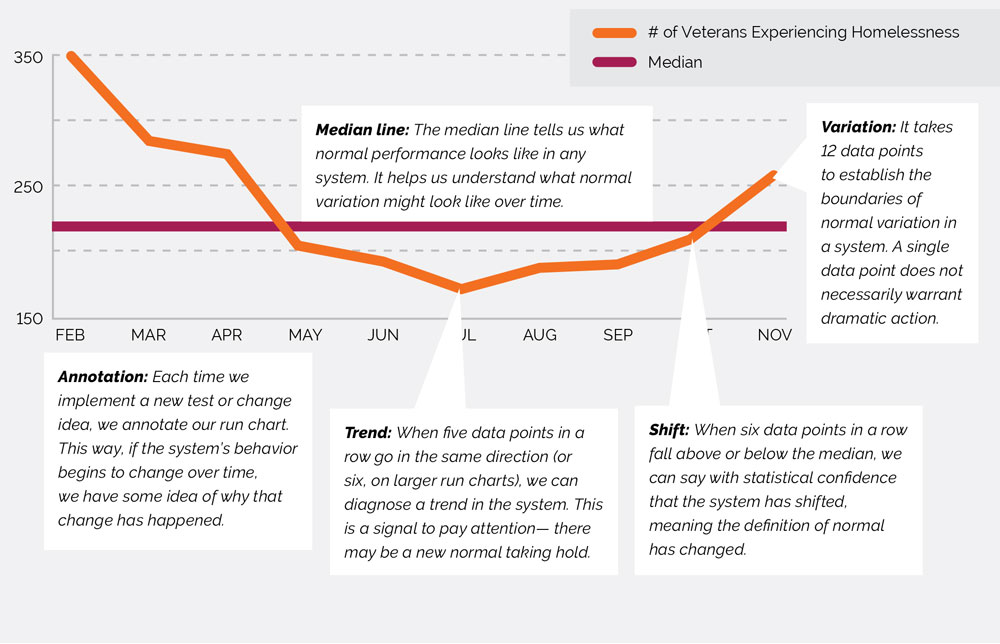Anchor Institutions (Healthcare)
Place-based and mission-driven organizations, including government agencies or healthcare and educational institutions that leverage their economic power alongside their human and intellectual resources to improve the long-term health and social welfare of their communities.
Balance of State (BoS)
Continuums of Care (CoCs) that cover the parts of a state not covered by any other CoCs. BoS CoCs include non-metropolitan areas, such as rural regions, and may include some or all the state’s smaller cities. In comparison, a “Statewide CoC” is one that covers every jurisdiction.
Bridge Housing
Continuums of Care (CoCs) that cover the parts of a state not covered by any oA short-term, transitional housing option in a safe environment for individuals who have accepted a permanent housing placement, but their permanent housing is not immediately available for occupancy.
Built for Zero
A national movement of cities and counties that have committed to measurably and equitably ending homelessness. Built for Zero is led by Community Solutions.
By-Name Data / By-Name List
A by-name list is a comprehensive list of every person in a community experiencing homelessness, updated in real time. Using information collected and shared with their consent, each person on the list has a file that includes their name, homeless history, health, and housing needs. This data is updated monthly, at minimum. At the population level, communities use their by-name data to track the changing size and dynamics of their homeless population, and whether efforts are reducing homelessness.
Case Conferencing
A recurring, problem-solving meeting that brings key participants together to collaborate on ways to remove barriers to help house clients faster. Teams work with real-time, by-name lists to coordinate resources, while figuring out how to generate and measure system improvements.
Chronic Homelessness
Long-lasting or recurring homelessness. It is defined by the federal government as a condition which impacts people who live with a documented disability and have experienced homelessness for at least a year–or repeatedly over three years.
Command Center
A unified regional team composed of key agencies, including Continuums of Care, housing authorities, local government, and the Department of Veterans Affairs (VA) working together toward a shared aim of ending homelessness in a community.
Community
In the United States, the physical span of most Built for Zero communities are represented by Continuums of Care, which are regional or local bodies that receive and disburse federal funding for housing and homelessness. There are more than 400 continuums of care in the country, and their geographic spans vary widely. When we refer to a Built for Zero community, we are often referring to a group that includes the Continuum of Care (usually comprised of local non-profit providers), the Housing Authority, and the VA Medical Centers.
Community Development Block Grant (CDBG)
A federal grant distributed by the U.S. Department of Housing and Urban Development. The funding supports community development activities to build stronger and more resilient neighborhoods. Initiatives may address needs such as infrastructure, economic development projects, community centers, housing rehabilitation, public services, code enforcement, and homeowner assistance, amongst others.
Continuum of Care (CoCs)
A network of agencies bound to a geographic area, and which included social services, healthcare, shelter services, and housing providers which organize and deliver funding and support to meet the needs of people experiencing homelessness. CoCs prioritize moving people to stable housing while helping them transition into maximum self-sufficiency. It can also refer to a federal grant distributed by the U.S. Department of Housing and Urban Development through which homeless service agencies can be funded.
Coordinated Entry System (CES)
A coordinated system whereby all providers allocate housing and services through a single process and according to shared protocol. A Coordinated Entry System contains three core components: access points by which people experiencing homelessness can enter into a shared response system; a standardized assessment and data procedure across the system; and shared prioritization policies in place to enable matching to housing supports and services.
Ending Homelessness
When we refer to ending homelessness, we mean that a community has reached functional zero, a standard developed by Community Solutions that indicates that homelessness in that community is rare overall and brief when it occurs. More detailed definitions of functional zero are listed below.
Ending homelessness does not mean that no person will ever experience homelessness in a community. It means that systems are in place to ensure that any experience of homelessness is brief and permanently resolved, and rare overall. As an analogy, a well-functioning health care system will not necessarily prevent people from getting sick. But it will ensure that people who fall ill are triaged appropriately and receive the services they need so their illness does not become a crisis.
Field Catalysts
Field-building intermediary organizations that help stakeholders gather momentum through action and investment to propel an issue toward change.
Functional Zero – Chronic
A community has ended chronic homelessness when the number of people experiencing chronic homelessness is zero, or if not zero, than either 3 or .1% of the total number of individuals reported in the most recent point-in-time count, whichever is greater.

Functional Zero – Veterans
A community has reached functional zero for veteran homelessness when the number of veterans experiencing homelessness is less than the number of veterans a community has proven it can house in a month, with a minimum threshold of 3.

Grant and per Diem (GPD)
U.S. Department of Veterans Affairs (VA) Grant and Per Diem (GPD) program provides transitional housing with the goal of helping homeless veterans achieve residential stability, increase their skill levels or income, and obtain greater self-determination.
Homeless Management Information System (HMIS)
Databases used to gather client-level data and inform the provision of housing and services to homeless individuals and families and persons at risk of homelessness. Quality HMIS data includes by-name records of individuals,their racial demographic, their length of time spent in the system, and their required or accessed services, etc.
Homeless Response System
The term refers to the various organizations and entities within an area that serve homeless individuals and families. These providers can include nonprofit organizations, housing authorities, local and federal government agencies, faith-based organizations, the VA, shelter providers, and other homeless coalitions.
Housing Choice Vouchers
Housing choice vouchers, formerly known as “Section 8,” enable low-income individuals or families to choose and lease affordable, privately-owned rental housing. Housing assistance is provided directly to the individual or family. Participants are able to select their own housing, including single-family homes, townhouses and apartments. Administered locally by public housing agencies (PHAs).
Housing First
A homelessness response philosophy that prioritizes giving people permanent housing, without preconditions, like mandatory treatment programs, sobriety, or other services. This approach highlights the need for stable, secure housing above all, which then serves as a solid foundation for further supportive services.
Housing and Urban Development (HUD)
Federal agency administering urban development laws. HUD provides housing assistance, disaster relief services, homeownership programs, and public housing. HUD also works to ensure equal and fair housing for all.
Inflow
The number of individuals entering homelessness and shelter services at any given time. This group includes those who are new to homelessness, and individuals with prior experience of homelessness into the system, including those who may be returning to the response system after a period of disengagement
Outflow
The number of individuals exiting homelessness and shelter services into housing at any given time. This definition also includes people who have entered safe and stable permanent housing, those who have lost contact with the system, and people who no longer meet the eligibility criteria of the sub-population.
People Experiencing Homelessness
We refer to individuals or groups as a person, people or populations experiencing homelessness, rather than referring to those people as “the homeless.” We avoid words and expressions that reduce a person’s identity to any single experience that they don’t claim themselves. Such labels can have a dehumanizing, disparaging and harmful impact on the people they aim to describe.
Permanent Supportive Housing (PSH)
Affordable, subsidized, non-time-limited housing operating under the Housing First philosophy. Participation in services is not required for residents of PSH, however services such as case management, health and mental health support, and other services are assertively offered. PSH is generally reserved for those with the highest barriers to independent community living.
Point-in-time (PIT) count
A Housing and Urban Development-mandated annual census count of people experiencing homelessness. The count includes both those who are sheltered and unsheltered. Usually, CoCs take charge of conducting the count. The resulting data is sent to federal agencies to create an Annual Homeless Assessment Report, which is used for the allocation of resources and support to homelessness services.
Prevention
An approach to prevent homelessness before it occurs. This sometimes requires working upstream, working with individuals at risk of homelessness and connecting them with community services to support their situation. Homelessness prevention is effective both at the individual and population level.
Public Housing Agencies (PHAs)
Often referred to as housing agencies or housing authorities, PHAs are federally funded and regulated organizations tasked with providing decent and safe affordable housing for eligible low-income families, the elderly, and persons with disabilities. PHAs administer programs such as public housing and housing choice vouchers.
Quality Improvement
A formal approach to the analysis of performance and procedures to improve solutions to a complex problem like homelessness. Quality improvement offers practices grounded in “systems thinking” — the idea that outcomes are the product of systems, and that improving outcomes requires changes to the system itself.
Quality By-Name List (QBNL)
Quality By-Name List, or Quality Data. This is by-name list data that can be confidently used to set goals and track progress because it meets qualitative BNL Scorecard standards and whose monthly data is balanced within a 15% data reliability threshold. Each entry includes an individual name, history, health and documentation of specific needs. Homelessness is categorized as veteran, chronic, family, single, or youth. The status for each individual can be followed through the system at any given time.
Quality Data (Also: see “By-name List”)
Data is considered quality when a system has all necessary controls in place to ensure that everyone experiencing homelessness is accounted for on the by-name list, and that the margin of error from month-to-month is no more than 15%.
Racially Equitable Homeless Response Systems Framework
An approach to integrating lasting practices for racial equity, which includes: by-name representation in data that is specific regarding race; meaningful input from BIPOC users regarding systems changes; no racial disparity in housing access, retention, or duration of homelessness; and no disparity in user satisfaction of the system.
Rapid Rehousing
A solution to homelessness designed to help individuals and families to quickly exit homelessness and return to permanent housing by offering flexible, time-limited assistance. It is offered without preconditions (such as employment, income, absence of criminal record, or sobriety) and the resources and services provided are typically tailored to the unique needs of the household.
Reduction
A measurable decrease in the numbers of people experiencing homelessness.
Rental Assistance
Programs that provide financial assistance with a household’s rent. It can cover all or a portion of rent costs.
Shelter Diversion
The practice of diverting a person experiencing homelessness from entering shelter (or other homeless services) by helping them to leverage their natural support system. Also sometimes called rapid resolution or housing problem solving.
Shift
A statistical signal that a system is performing differently from before, and that the new performance is due to more than chance. This is defined as measuring six or more consecutive data points either all above or all below the latest improvement median.

Systems Change
In the work of Built for Zero, systems change is understood as a critical pathway to reducing and ending homelessness. Homeless response systems — and other intersectional systems — apply principles of quality improvement to understand, test, and apply improvements toward their systems that can accelerate progress toward functional zero.
Tableau
Software that can be used to visualize data (to create interactive charts and graphs).
Transitional Housing
Time-limited housing for homeless individuals or families. Transitional housing also offers supportive services to assist people in shifting from homelessness to permanent shelter and stability. Transitional housing is now only recommended for special populations, such as youth, people with substance use disorders, and people fleeing or attempting to flee domestic violence.
United States Interagency Council on Homelessness (USICH)
The only federal agency with the sole mission of preventing and ending homelessness in America. USICH coordinates with our 19 federal member agencies, state and local governments, and the private sector to create partnerships, distribute resources and funding, and implement systems practices to resolve homelessness across the nation.



